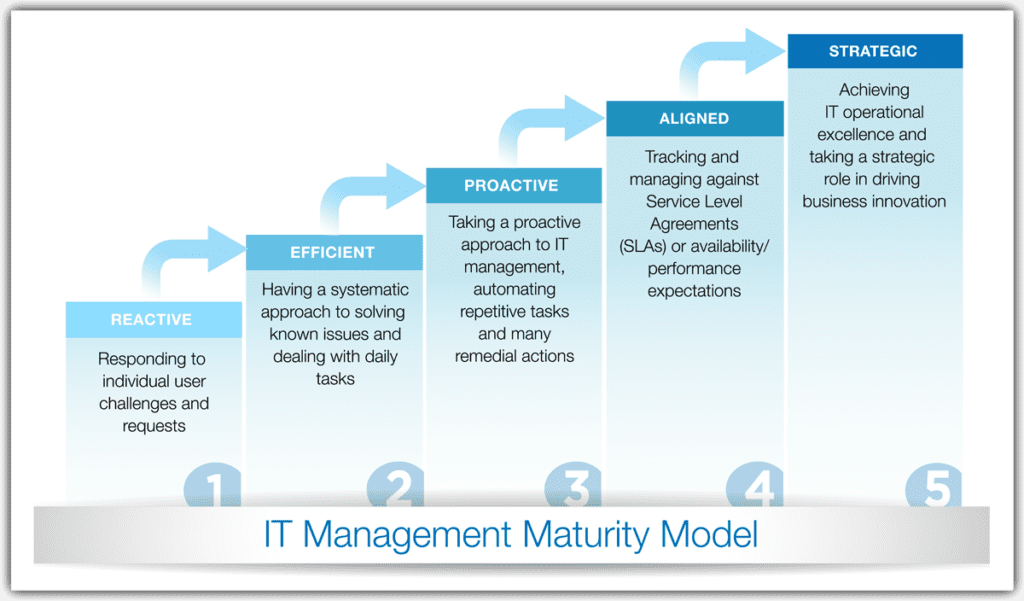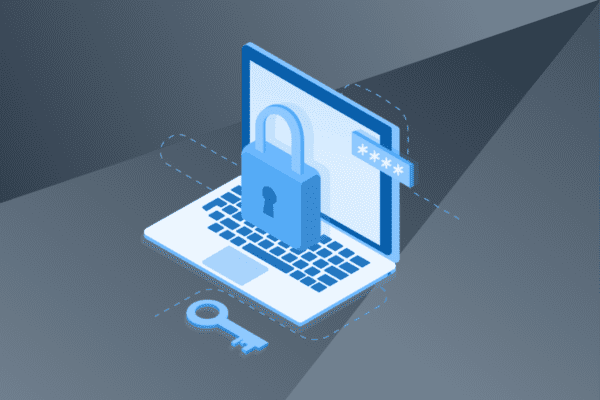There is no shortage of IT maturity models, which are guidelines on how to create and optimize a progressive IT infrastructure.
These models were devised years ago when big consulting firms and integrators such as IBM and Electronic Data Systems Corp. (EDS), now owned by HP Enterprise, analyzed the operations of large enterprises. They would then craft a detailed plan to simplify IT and make it more efficient and productive.
Microsoft even jumped in a decade ago with its Infrastructure Optimization (IO) framework, a maturity model largely focused on making Microsoft shops more modern.
None of these approaches fit the bill for small and mid-sized businesses (SMBs). And it is SMBs that need this kind of help the most. That’s why Kaseya developed an IT Management Maturity Model specifically for companies ranging from less than 50 to up to 3,000 employees.
Not only that, but every year we do extensive research to figure out how the most mature SMB IT shops do it, and what lessons they can offer to the rest of us.
A Maturity Model Just For SMBs
Here is an outline of Kaseya’s five-step Maturity Model:

Establishing Your IT Maturity Level in the Kaseya Model
Knowing your level of maturity lets you set goals so you can reach higher levels. And the higher you reach, the easier the job of IT becomes. Oh, and you become far more effective at the same time. How can you go wrong?
In our piece “Benchmarking Your IT Maturity,” we explain that, as you increase your maturity level, your IT team spends less time fighting fires and more time contributing to strategy creation and execution. Your IT group moves from a cost center to a generator of innovation that drives business success.
Here are the five stages of Kaseya’s IT Management Maturity Model:
- REACTIVE: Responding to individual user challenges and requests
- EFFICIENT: Having a systematic approach to solving known issues and dealing with daily tasks
- PROACTIVE: Taking a proactive approach to IT management, automating repetitive tasks and many remedial actions
- ALIGNED: Tracking and managing against service level agreements (SLAs) or availability/ performance expectations
- STRATEGIC: Achieving IT operational excellence and taking a strategic role in driving business innovation
Stage One – Reactive
As you can see, the lowest stage, Reactive, is the most stressful, least efficient, and produces the smallest amount of increased business value. It is as close to an ad hoc scenario as you can imagine.
This stage is characterized by IT departments dealing with short-term reality, and not having the time to think and act in a true forward-looking way. There is no blame here, but things can be done in a far better way. Without proper planning and processes, IT is too busy fighting fires that have to do with keeping the lights on without being able to focus on new services. The result is a constant struggle and scramble to fix problems.
These weaknesses become apparent as both business leaders and the IT department spot the inefficiencies and have no choice but to confront them.
The solution is to aspire to a higher level. This is not for the sake of ego; it is for the sake of IT efficiency.
Stage Two – Efficient
Efficient sounds pretty good, and it is. Only it could be far better. At this level, there is a system in place to handling recurring issues, and processes and tools in place to:
- Handle security and compliance on a basic level
- Consolidate systems management and reporting into a single view
- Conduct audits and device- and network-discovery
The big breakthrough is a systematic management process, backed by advanced tools that boost IT efficiency. In this stage, IT has solutions that manage and report on IT resources centrally; all systems are monitored for security, performance and operations; and there is regular auditing of IT resources that help insure they are all identified and subject to monitoring and protection.
Antivirus/anti-malware measures have been taken, passwords are required to be strong and regularly updated, and there is strong user authentication.
This is all good stuff, but there many issues left to address. In this stage, IT is not yet acting proactively.
Stage Three – Proactive
With the Proactive level you are really getting someplace – someplace good. The key is using IT automation to make operations safer and more efficient.
This way, a majority of IT grunt work is done away with as these tasks are automated and guaranteed to take place on a consistent basis – including patching and updating systems, installing new virus definitions, and more.
Maintenance can be automated and based on events. For example, if a disk is too full, it can be automatically cleaned up. Backups can be redone in the case of an earlier failure without admin involvement.
Even better, automation can be applied to problem solving. And not just in reaction to problems, but in order to proactively identify emerging problems and often solve them without significant IT staff intervention.
This stage is a huge breakthrough and those who have reached it should be proud. However, IT services do not yet always precisely meet business needs – such as adopting new services or applications to make end users more productive or the company more competitive
Stage Four – Aligned
This penultimate stage, Aligned, is all about IT seamlessly and effectively meeting business priorities – and in fact identifying these needs before being called upon to meet them.
At this level, there is a deep and detailed agreement between IT and the business leaders over the services and service levels. Because IT is fully automated and measured, the technical staff can focus the bulk of its efforts on creating true business value. The only thing missing is allowing IT to have a full view of future strategic needs that can be enabled by new technology.
Stage Five – Strategic
The Strategic level is where IT reaches its peak and struts it stuff. Now IT is 100% involved in moving the business forward. At the same time, services are running at peak efficiency and are built to match what the business is all about. The result is the business grows in revenues, profits and innovation.
Microsoft on the Right Maturity Track
A decade or so ago, Microsoft created the Infrastructure Optimization Model. This model jives pretty well with the Kaseya model. Where Kaseya has five stages, Microsoft has four — Basic, Standardized, Rationalized and Dynamic.
Basic: Many SMBs are still at this stage. Here the company buys technology on an as-needed basis, say when a PC dies or a hard drive runs out of gas. The replacements are often what is cheapest, with no mind as to standards, integration or where the organization wants to go in the future.
Standardized: While only the second level, being standardized is a huge step forward. Here your key applications and bits of infrastructure all adhere to some kind of standard or blueprint, and are chosen based in part on how well they work with the rest of your infrastructure. The main thing that is lacking is automation of key IT processes.
Rationalized: At this stage, the IT shop is making major headway. Not only are all the pieces standardized, they are automated and well-managed.
Dynamic: This represents the cream of the crop for IT shops where systems management is fully automated and IT serves as a strategic business enabler rather than a cost center.
An Array of Other Optimization and Maturity Models
IT maturity models have been around for so long, they themselves are mature. Here is a rundown of key models that established the field – all of which are built for large companies and are not amenable for SMBs
CMMI: Carnegie-Mellon isn’t just a technical innovator. The school after all created Mach, a version of UNIX that is now the basis of Apple’s Mac OS. It was also one of the earliest developers of an IT maturity model. The university’s Software Engineering Institute built the CMMI or the Capability Maturity Model Integration. This model focuses quite a bit on organizations, processes and people.
MIT: Another learning institution, the prestigious Massachusetts Institute of Technology (MIT), has a 4-level IT operating model built by the Center for Information Systems Research. Unlike other models, the levels don’t progress in quality, but describe different IT approaches and their strengths and weaknesses.
Here are those 4 levels:
- Diversification: The technology has minimal integration and standardization.
- Unification: There is both maximum integration and standardization at this level.
- Coordination: This level boasts great integration, but poor standardization.
- Replication: This is the opposite of coordination where there is poor integration, but great standardization.
IBM: IBM’s IT Transformation and Optimization Consulting Services is designed to establish blueprints to assist IT in simplify their infrastructure, change technology in response to shifting market conditions, and make sure IT is aligned with business objectives. This can ultimately even impact corporate culture.
Take a Kaseya Maturity Deeper Dive
Kaseya has five eBooks that help you figure out your own maturity level, and how you can move to a higher level.
The first, Benchmarking Your-IT Maturity, offers an overview IT maturity for SMBs and MMEs.
The next eBook provides tactical next steps to help you attain each higher rung in the IT Maturity model:
Lastly, we have a webinar Best Practices to Benchmark Your IT Maturity Level.





